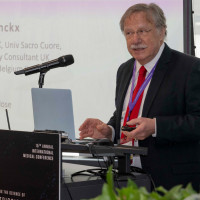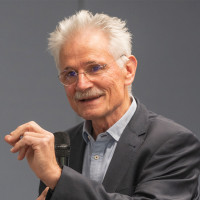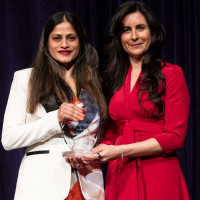
For the last eight years, Joella Nicole has pushed her body to its limits through sports. She recently registered for the Javelina Jundred, a 100-mile ultra-marathon held in October just outside Phoenix. Whether her body will allow her to participate remains to be seen.
“I want to take my time getting back to fitness and feeling good and overall healthy again before I push that kind of mileage and focus on that goal,” Nicole said.
Nicole, 38, is a marriage and family therapist who splits time between Palm Harbor, Florida, and Bend, Oregon. Her endometriosis story is unique in that when she was 11 and had her first period, which lasted five weeks, she knew it was likely from the disease.
“My mom had endometriosis,” she said. “I watched her have two unsuccessful ablation surgeries and a hysterectomy when she was 36, so she suspected right away what was going on with me and was able to advocate for me. I was put on birth control and remained on it until just a few years ago.”
Nicole said birth control helped her function day-to-day over the years, though maybe not as much as she thought, now that she knows how bad her endometriosis was.
“I had quite a few flare-ups where I’d have fatigue, but I blamed them on other things,” Nicole said. “And my periods continued to be really painful. I didn’t know there were other options for how to treat it, so I just kept enduring the symptoms and controlling the variables I could, like my diet or when I did my most difficult training. I think I’d just gotten used to it and kept normalizing it for myself.”
Nicole paid more attention to her physical health in her early 30s when she got into several high-endurance sports, like ultra-running, trail running, and skiing. Growing intolerant of the side effects of birth control, she went off it for the first time in more than two decades.
“And I felt amazing,” she said. “I was still having terrible periods every month for five days, so I’d endure those five days and enjoy the rest of the month without the side effects. I also experienced some increased performance because I think my body was able to recover better without the extra hormones.”
But a couple of years ago, her periods became more painful and lasted longer than the usual five days.
“I would have horrible cramps around ovulation, cramps leading up to my period, cramps after my period. It just grew and grew until it was almost nonstop.”
Nicole said she “hit a wall” in October last year when she ran in the Javelina Jundred. The first time she ran the race, in 2021, she completed 60 miles. In 2022, she increased that to 80 miles. Expecting to finish the race last year without much difficulty, she ran just 50 miles.
“During that race, I developed a rash and spiked a fever,” she said. “Even a month before that, I was having crippling fatigue nonstop.”
Her health went downhill from there.
“After October, it was unrelenting,” Nicole said. “Constant pain, fatigue, cycles all over the place timing-wise, hives on a regular basis, chronic right hip pain. It just didn’t let up. I also had to cut way back on my work because of everything going on.”
That caused her partner, who was aware of Nicole’s mother’s battle with endometriosis, to research the disease. He found a book about it and an article on renowned conservationist Bindi Irwin, who went public last year about her endometriosis journey. While it seemed obvious to him that endometriosis was likely causing Nicole’s issues, it wasn’t as apparent to her.
“There were so many variables going on in my life,” Nicole said. “I was running regularly 50 to 75 miles a week. I just thought the fatigue and everything else could have been what happens when you run and train that much. But he could see more clearly my fitness before versus what it had become.”
Nicole opted to have surgery in February.
“I had 30 lesions, and a majority were along my right side in the peritoneum,” she said. “They were also attached to my psoas muscle, appendix, and bladder.”
Though extensive, it appears the surgery was successful.
“Within three days, I felt mentally clearer and had way less fatigue, and it was shocking,” Nicole said. “The pain from the surgery felt like nothing compared to how bad I felt before the surgery. I had a couple of days where I didn’t feel quite right, but I’m on my fifth day in a row now where I can do a half-hour of activity and not need a nap.
Nicole said the critical element of her story isn’t the pain she endured.
“It’s that I continued to go to doctors who told me that painful periods were okay, even though I was describing to them that for five days every month, I did nothing,” she said. “I didn’t train, I wasn’t with my friends, I didn’t go out, I cut back at work. But the feedback I was getting from physicians was that that was okay and within reason.
“I had doctors and naturopaths telling me everything from, ‘You’re overtraining’ to ‘You’re in perimenopause,’” she continued. “And that was after I always approached them with, ‘Hey, I think I have endometriosis, and I have a lot of evidence,’ but nobody listened. When you have professionals who are supposed to know about this stuff tell you that’s not it, it keeps you in that loop, too.”
Nicole hopes her story encourages women to advocate for themselves, even when continually dismissed. Finding the right solution took her a long time, but it was worth the effort.
“My surgery was just 20 days ago, but from the walking I’ve been doing and my swim this morning, I already feel so much less fatigued,” she said. “If my periods can be more reasonable each month, which I’m waiting to see, what that will do for stabilizing my training makes me very excited.”








